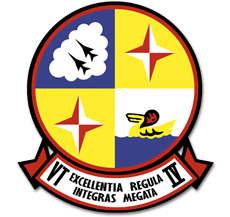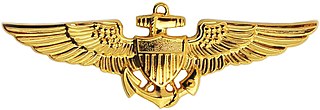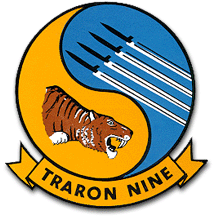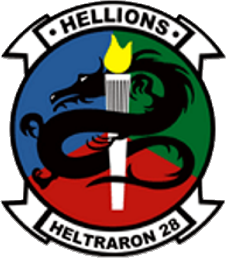
The McDonnell DouglasT-45 Goshawk is a highly modified version of the British BAE Systems Hawk land-based training jet aircraft. Manufactured by McDonnell Douglas and British Aerospace, the T-45 is used by the United States Navy as an aircraft carrier-capable trainer.

The North American T-2 Buckeye was the United States Navy's intermediate training aircraft, intended to introduce U.S. Navy and U.S. Marine Corps student naval aviators and student naval flight officers to jets. It entered service in 1959, and was replaced by the McDonnell Douglas T-45 Goshawk in 2008.
A Naval Flight Officer (NFO) is a commissioned officer in the United States Navy or United States Marine Corps who specializes in airborne weapons and sensor systems. NFOs are not pilots per se, but they may perform many "co-pilot" functions, depending on the type of aircraft. Until 1966, their duties were performed by both commissioned officer and senior enlisted naval aviation observers (NAO).

VT-4 Training Squadron 4 is a training squadron of the United States Navy. Initially established as Basic Training Group NINE (BTG-9) in the 1950s, the squadron was redesignated as Training Squadron FOUR (VT-4) on May 1, 1960 and based at Naval Air Station Pensacola, Florida.

Naval Air Station Corpus Christi, is a United States Navy naval air base located six miles (10 km) southeast of the central business district (CBD) of Corpus Christi, in Nueces County, Texas.

Vance Air Force Base is a United States Air Force base located in southern Enid, Oklahoma, about 65 mi (105 km) north northwest of Oklahoma City. The base is named after local World War II hero and Medal of Honor recipient, Lt Col Leon Robert Vance Jr.

Naval Air Station Whiting Field is a United States Navy base located near Milton, Florida, with some outlying fields near Navarre, Florida, in south and central Santa Rosa County, and is one of the Navy's two primary pilot training bases. NAS Whiting Field provides training for U.S. Navy, U.S. Marine Corps, Coast Guard, and Air Force student pilots, as well as those of several allied nations. NAS Whiting Field is home to Training Air Wing Five.

Naval Air Station Meridian or NAS Meridian is a military airport located 11 miles northeast of Meridian, Mississippi in Lauderdale County and Kemper County, and is one of the Navy's two jet strike pilot training facilities.

A naval aviator is a commissioned officer or warrant officer qualified as a pilot in the United States Navy, United States Marine Corps or United States Coast Guard.
A Combat Systems Officer is a flight member of an aircrew in the United States Air Force and is the mission commander in many multi-crew aircraft. The combat systems officer manages the mission and integrates systems and crew with the aircraft commander to collectively achieve and maintain situational awareness and mission effectiveness. CSOs are trained in piloting, navigation, the use of the electromagnetic spectrum, and are experts in weapon system employment on their specific airframe. Aircrew responsibilities include mission planning, mission timing, weapons targeting and employment, threat reactions, aircraft communications, and hazard avoidance.

The VT-9 Tigers is one of four U.S. Navy strike jet training squadrons and one of two based at Naval Air Station Meridian in Mississippi.

Training Squadron TEN (VT-10) is a training squadron of the United States Navy. The squadron is homebased at NAS Pensacola, Florida.

Training Squadron 86 (VT-86), also known as the "Sabrehawks," is a United States Navy advanced training squadron based at Naval Air Station Pensacola, Florida. They are a training squadron flying the T-45C Goshawk. Their tailcode is F and their radio callsign is ROKT.

Naval Air Station Kingsville or NAS Kingsville (NASK) is a United States Navy Naval Air Station located approximately 3 miles east of Kingsville, Texas in Kleberg County. NAS Kingsville is under the jurisdiction of Navy Region Southeast and is the headquarters of Training Air Wing Two.

Helicopter Training Squadron 28 (HT-28) is a United States Navy helicopter training squadron based at Naval Air Station Whiting Field in Milton, Florida. The squadron, known as the Hellions, is one of three Advanced Helicopter Training squadrons that produces aviators for the Navy, Marine Corps and Coast Guard. They fall under the command of Training Air Wing Five and fly both the TH-57B Sea Ranger basic helicopter trainer and the TH-57C Sea Ranger advanced helicopter trainer. The squadron's tactical call sign is "Lucky."

The Naval Air Training Command (NATRACOM) is a one star command that conducts flight training of student Naval Aviators, and Naval Flight Officers. Though it does not conduct Naval Aircrew training which is conducted by Naval Education and Training Command's Naval Aviation Schools Command (NASC), it is responsible for monitoring the production of Aircrewmen through the Naval Aviator Production Process (NAPP). Through the NAPP, NATRACOM is also responsible for programming and monitoring the production of all Navy and Marine Corps Fleet Replacement Squadrons.

VFA-127, nicknamed the Royal Blues from the 1960s to 1980, and the Cyclons from 1981 onward, was a Strike Fighter Squadron of the U.S. Navy. Established as an Attack Squadron designated VA-127 on 15 June 1962 at NAS Lemoore, California, it was redesignated VFA-127 on 1 March 1987 and disestablished on 23 March 1996.

Training Squadron 22 (VT-22) or TRARON TWO TWO, known as the Golden Eagles, callsign "Blazer", is a U.S. Navy strike jet training squadron stationed aboard Naval Air Station Kingsville, flying the T-45C Goshawk. The Golden Eagles are one of four strike jet training squadrons in operation today, and are under the command of Training Air Wing Two.

Training Air Wing TWO is a United States Navy aircraft training air wing based aboard Naval Air Station Kingsville, in Kingsville, Texas. TW-2 is one of five training air wings in the Naval Air Training Command, and consists of two jet training squadrons. The wing trains Student Naval Aviators from the U.S. Navy, U.S. Marine Corps, and international allies. Following completion of primary flight training and selection of an advanced training pipeline, Student Naval Aviators are assigned to TW-2 for either intermediate and advanced strike pipeline training or advanced E-2/C-2 training in the T-45C Goshawk jet training aircraft.

Training Squadron 21 (VT-21), known as the Redhawks, is a U.S. Navy strike jet training squadron stationed aboard Naval Air Station Kingsville, Texas flying the T-45C Goshawk. The Redhawks are one of four strike jet training squadrons in operation today, and are under the command of Training Air Wing Two.





















